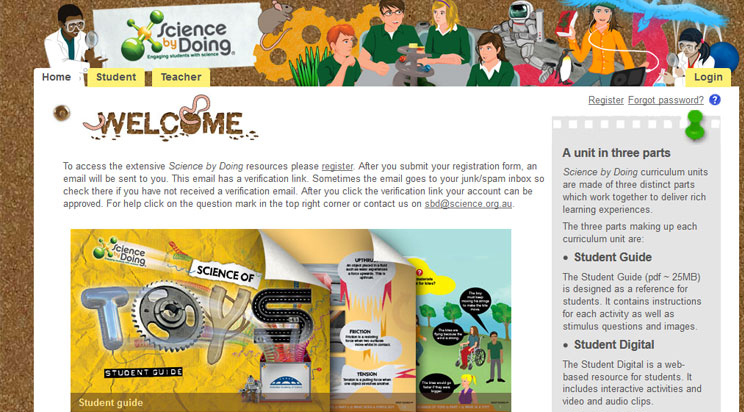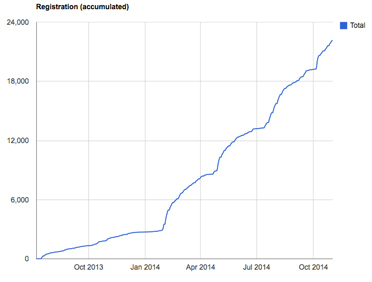
Small schools, big schools, city, rural and isolated schools: Science by Doing units are on the march if website activity and school feedback is a good indicator.
The Science by Doing website was launched one year ago. By October this year it had recorded 1.47 million hits. The table shows the number of hits for the middle month of each term since the website went live. This is a more reliable indicator of the active use of Science by Doing resources.
The graph illustrates the trend in accumulated registrations (students, teachers and others) since mid-July 2013; note the impact of the school terms. An estimated one in five high school science teachers are registered.

| Month | Number of hits |
|---|---|
| August 2013 | 131,456 |
| November 2013 | 274,765 |
| March 2014 | 950,062 |
| May 2014 | 1,102,453 |
| August 2014 | 1,133,146 |
| October 2014 | 1,471,130 |
While the website activity reaffirms the appeal of a comprehensive and high quality digital resource reflecting the Australian curriculum (the first of its kind), the feedback from science leaders in the trial schools illustrates the positive impact of Science by Doing in the classroom—where it matters most!
Many of the SBD [Science by Doing] activities also foster the student's imagination and love for science. One that comes to mind is the 'sewer lice' activity involving currents, coke and tonic water where the student initially believed that I had captured live animals from the sewers. These tasks make the lessons fun and engaging and all the while the students are learning the fundamentals of secondary science.
Batchelor Area School, NT
The challenge for our department was to shift pedagogy from teacher centred to enquiry approach…I believe SBD has helped us make a quantum leap….rapidly.
Mary Star of the Sea, NSW
Our teachers have benefited from the modern, relevant and engaging curriculum the AAS has presented. The program’s full content means that you are able to make decisions on how far and deep your students can go and thus offers that flexibility from year to year.
Christies Beach High School, SA
We have had positive feedback from parents such as they wished they had learned science like that at school, it looked much more interesting and fun.
Trinity Goulburn, NSW
There is plenty of hard work and creative effort still ahead of us as we work with writers, graphic artists and digital experts to complete the remainder of the units to the program’s high standard.
The year 10 chemistry unit, Chemical Patterns, is currently being trialled and includes digital career resources on science journalism which features a video clip with the Academy’s Director Communications and Outreach, Kylie Walker. The students learn about science journalism and, similar to the ABC series Checkout, complete an assessment task on the chemicals in consumer goods such as those found in toothpaste and high energy drinks.
Fellows and others who are interested in science education are encouraged to register for Science by Doing.
© 2025 Australian Academy of Science